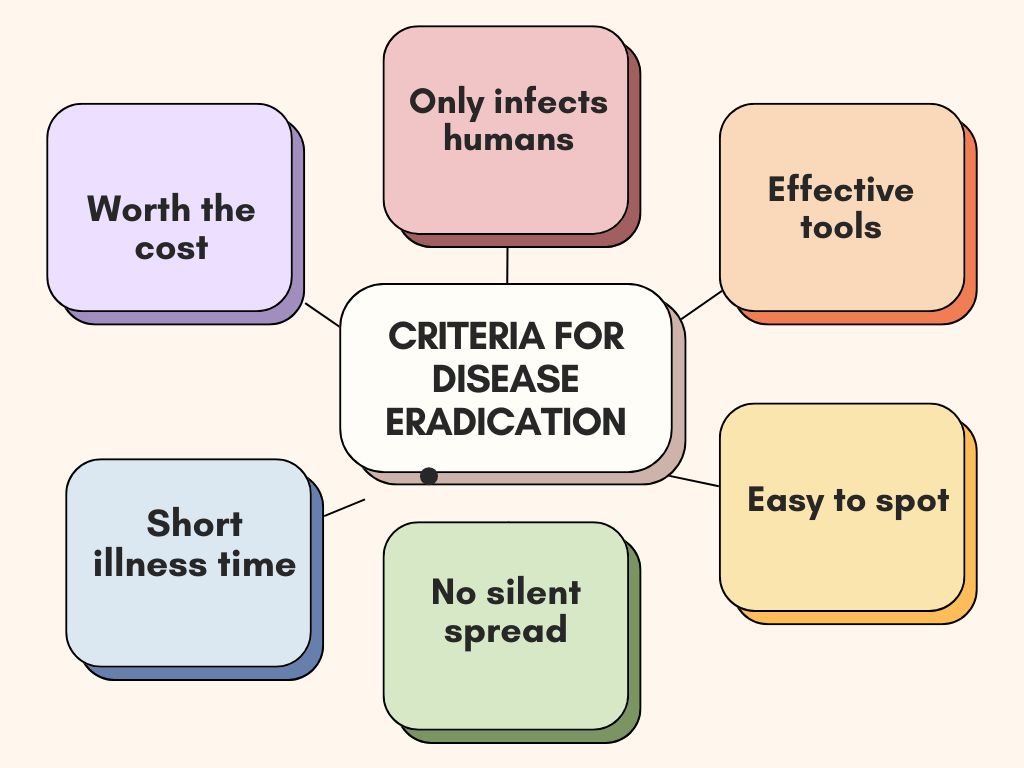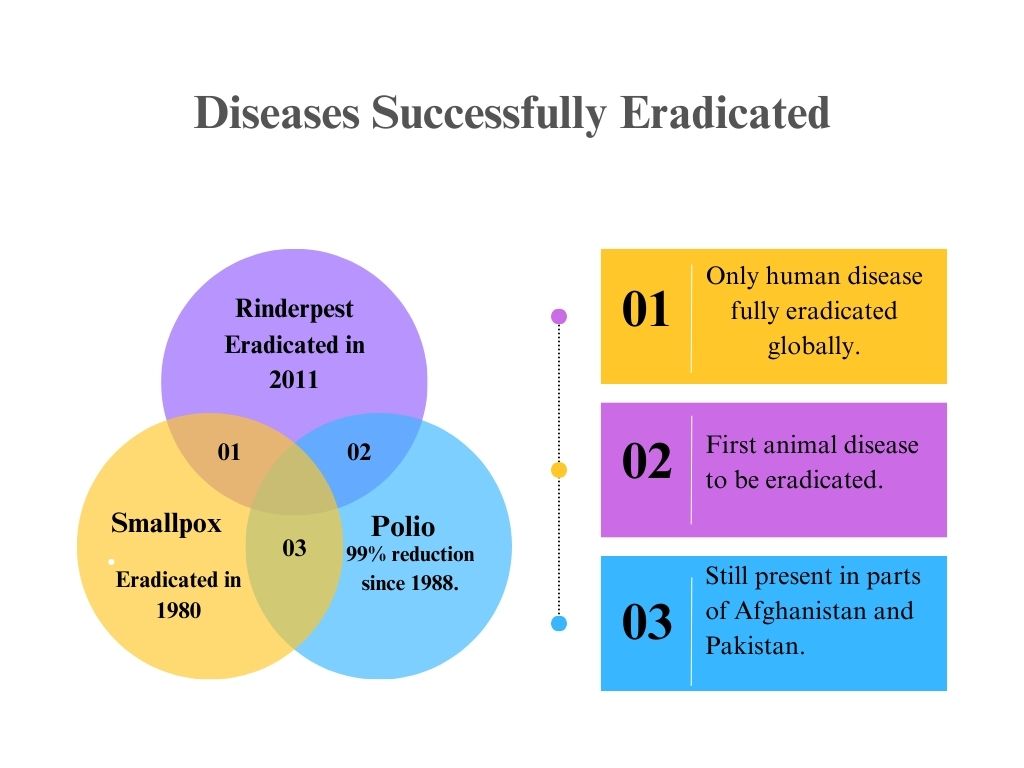The ultimate goal in the fight against illnesses is their total eradication. The elimination and eradication of human diseases has been the subject of countless public health campaigns, conferences, seminars, and planning sessions for more than a century. Despite the failure of previous attempts to eradicate yaws, yellow fever, and malaria, they greatly improved our knowledge of the biological, social, political, and economic challenges associated with doing so.
Disease Eradication
Eradication is the state in which the disease’s causal agent has disappeared and no intervention measures are required. Theoretically, it is possible to remove many diseases. But in practice, very few illnesses fit the requirements that would allow them to be eradicated using the institutions, technology, and knowledge we now possess. The only infectious disease in humans to be completely eradicated by vaccination is smallpox. With only Central Asia reporting wild infections (as opposed to vaccine-derived cases), polio is almost completely eradicated. The only animal illness that has been eliminated by livestock immunization is rinderpest, a measles-related disease that affected cattle.
Eradicable Disease Criteria
The science, the political environment, and the economic aspects of a disease must all be considered in order to determine whether it can be eradicated. By focusing on scientific standards, academics and public health specialists can evaluate smallpox and rinderpest eradication efforts. Certain traits that were present in both of these illnesses helped to eradicate them.

For an infectious agent to be eliminated, it must meet a number of requirements.
- First, it must be simple to identify the infectious agent. The observable symptoms of smallpox, for example, made isolation and quarantine effective. If there are no outward signs of an illness, accurate laboratory testing is required.
- Second, a highly effective vaccine must be accessible to at-risk populations, ensuring herd immunity. For example, the measles vaccine is about 99% effective, but its effectiveness decreases if vaccination rates drop.
- Third, public acceptance of the vaccine is crucial. Even the best vaccines can’t guarantee eradication if a significant portion of the population refuses to be vaccinated, which is a growing issue due to misinformation.
- Finally, it should be difficult for the infectious agent to spread from one animal species to another. For instance, influenza is not a candidate for eradication because it transmits between humans and animals, but it might be if a universal vaccine is created that works.
The International Task Force for Disease Eradication (ITFDE)
The Bill & Melinda Gates Foundation supports the ITFDE, which was founded in 1988 at The Carter Center and advises institutions such as the World Health Organization on a range of disease eradication matters. The ITFDE established precise criteria for assessing eradication potential, examining 94 diseases in total and thoroughly reviewing 30 of them, including one non-infectious condition. It concluded that six diseases—poliomyelitis, mumps, rubella, lymphatic filariasis, cysticercosis, and dracunculiasis—could probably be eliminated using the technology available today. In order to discuss the “global impact of climate change on health” and “how climate change affects disease eradication and elimination,” the International Task Force for Disease Eradication held its 36th meeting in a hybrid format (both virtual and in-person) at the Carter Center in Atlanta, Georgia, on October 5–6, 2023. The challenges presented by climate change, especially for nontropical diseases, are multifaceted; more research is necessary to fully understand the complexities of human-driven changes, the unpredictable nature of future climate impacts, and the requirement for localized climate change models.
Successful Eradication
Smallpox is recognized as the first and only infectious disease in humans to be eradicated through intentional efforts. It was the first disease for which a successful vaccine was developed in 1798 when Edward Jenner demonstrated the protective benefits of inoculating people with material from cowpox lesions. Smallpox, which is caused by the variola virus (VARV), and rinderpest, which is caused by the rinderpest virus (RPV), are the only two illnesses that the World Health Organization (WHO) has formally proclaimed eradicated thus far. Smallpox was an old disease that caused epidemics throughout human history, killing between 300 and 500 million people, or 10% of all deaths in the 20th century. Rinderpest was a deadly illness that killed large herds of cattle in Europe and Africa during the 18th and 20th centuries. It was eradicated thanks to a concerted international effort.

Other diseases on the list for Eradication
There is hope that a number of other viral diseases could soon be eligible for global eradication if enough resources, effort, and international collaboration are provided. These diseases, in order of their likelihood of eradication, include polio, measles, and rubella. All of these meet the essential criteria for eradication. Nevertheless, smallpox eradication benefited from many unique factors, and each of these other diseases presents significant challenges that must be addressed before eradication is achievable.
Only 13 instances of guinea worm illness were reported in 2022 from the Central African Republic, Chad, Ethiopia, and South Sudan, suggesting that the disease is probably almost eradicated. Six other illnesses have been suggested as possibly eradicable by the Carter Center International Task Force for Disease Eradication: pork tapeworm, polio, measles, mumps, rubella, and lymphatic filariasis (elephantiasis).
Lessons Learned from Smallpox Eradication
Key takeaways from the global smallpox eradication effort include that before implementing eradication efforts, the necessary vaccination technology must be accessible and the viability of eradication must be demonstrated in theory. Poor planning can result in costly mistakes and, more importantly, erode confidence in public health leaders who are leading these initiatives.
References
Hopkins, D. R. (2013). Disease eradication. New England Journal of Medicine, 368(1), 54-63.
Dowdle, W. R. (1998). The principles of disease elimination and eradication. BULLETIN-WORLD HEALTH ORGANIZATION, 76, 22-25.
Dowdle, W. R., & Cochi, S. L. (2011). The principles and feasibility of disease eradication. Vaccine, 29, D70-D73.
Barrett, S. (2003). Global disease eradication. Journal of the European Economic Association, 1(2-3), 591-600.

